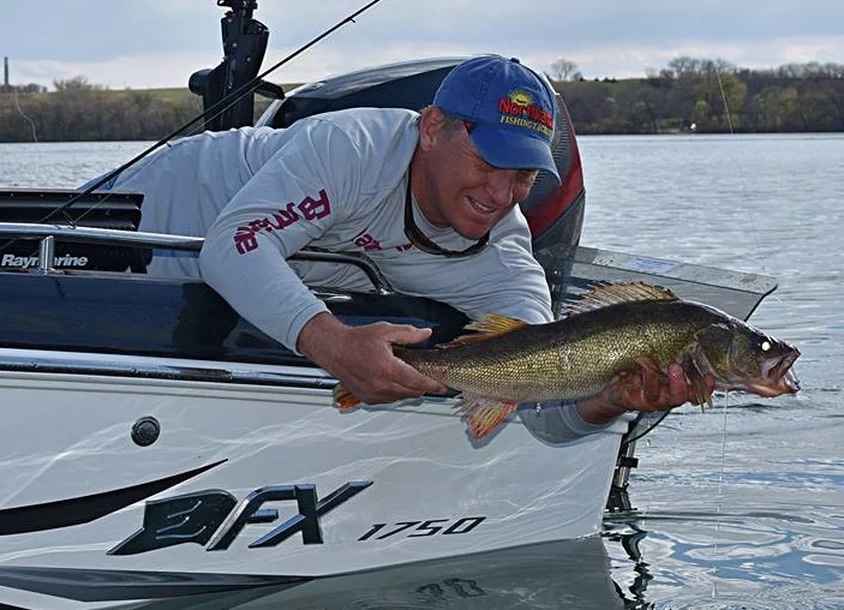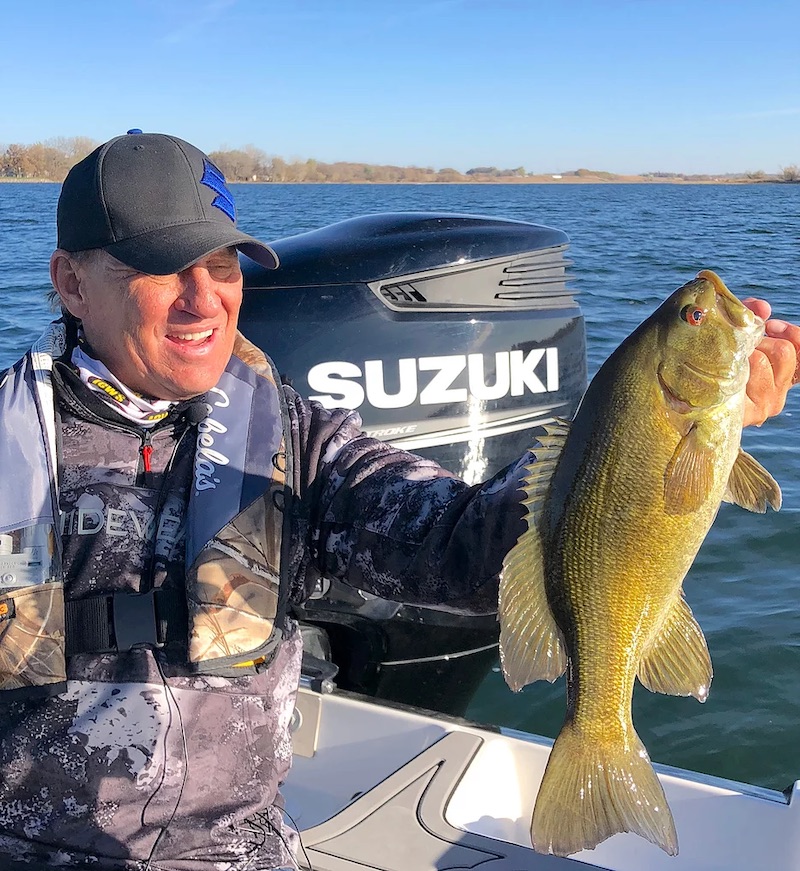News & Stories
Adapt To Catch More
Posted by admin on March 25, 2019

By Mike Frisch
Open-water fishing opportunities are starting to happen across the Midwest. One goal that I have coming into this season is to be more observant for changes that affect fish location and behavior. Because, in my experiences, reacting to change is often key to fishing success!
For example, one big change that is noticeable in lots of lakes is the increased water clarity often encountered. Spreading zebra mussel populations often “get the blame” for increased water clarity.
Clear water means fish locations change and changes in their feeding patterns occur too. Fish tend to locate in deeper waters when clarity increases and, they often feed more during the low-light periods of early morning and late evening.
In response to these changes, I often find myself on the water earlier or later in the day and productive fishing depths are now often deeper. For example, one of my favorite shallow water walleye lakes kicked out good catches in 7- to 10-feet of water in years past. Now, 12- to 25-foot depths are often more productive.
Clear water also affects lure selection. For example, a bright “firetiger” color pattern used to be one of my favorite crankbait color patterns. Now, however, more lifelike “match-the-hatch” color patterns that imitate perch and bluegills are often more productive.
To illustrate these points regarding deeper fish and them being more to susceptible to natural colored lures, I’ll reference some recent bass fishing experiences while fishing with crankbaits.
The past two falls have yielded excellent catches throwing Pro Model Series 5XD baits along deep weedlines where I used to throw Series 5 baits. The “XD” stands for Xtra Deep and the deeper divers are getting more play now because the weedlines I fish are now often deeper.
And, the more natural color patterns in these baits, colors like neon bluegill, natural bream, and yellow perch are getting more positive responses from the bass than some of the brighter colors.
Water clarity changes are affecting fishing, but so will many other factors. For example, as I write this, we still have deep snow and it’s currently raining hard, probably meaning lakes with higher water levels than normal will be encountered this spring.
How will that affect the coming fishing season? I’m guessing bass fishing may be good in the shallows this year as there will be deeper water and more fish-holding submerged cover along shorelines. Walleyes might stay shallower a bit longer this year too, as heavy spring run-off might mean dirtier water and more baitfish roaming shallow.
These, however, are just guesses! The key, as always, will be to be observant to current conditions concerning things like water clarity, water levels, and weather conditions and then react accordingly.
Because, sure as spring is coming, conditions will change and the anglers who react best to those changes will probably put the most fish in the boat this summer!
Good luck on the water and, as always, remember to include a youngster in your next outdoors adventure.
PHOTO –Here’s a big walleye caught from shallow water. Adapting to changing water levels is just one factor that affects fishing success!
Mike Frisch hosts the popular Fishing the Midwest TV series and is a co-founder of the Bass Pro Shops and Cabela’s School of Fish. Follow Fishing the Midwest on Facebook to see more from Mike.
Different things
Posted by admin on March 25, 2019

By Bob Jenson
As most of us know, we go fishing for different reasons. Some anglers go fishing to catch some bass, others go in hopes of catching a musky. Bass anglers generally catch more bass than musky anglers do muskies. Some anglers like to be in the outdoors by themselves or with friends. And some anglers want to catch some fish for the table. We had an interesting situation on 1 of our recent episodes of Fishing the Midwest television regarding our style of fishing on that particular episode. Let me explain.
We get a good amount of feedback on the various episodes of Fishing the Midwest, and we also get ideas/suggestions for topics that viewers would like us to cover. As mentioned earlier, some anglers, even many anglers, like to have a fish fry at their home, and not many fish are better for a fish fry than perch. We decided to do a segment for Fishing the Midwest television on what is perhaps the best way to catch a good number of perch in a short period of time.
The first thing that we needed to do was select a lake, and that didn’t take much time. Big Stone Lake on the Minnesota-South Dakota border is about as good as it gets for perch: Lots of perch in a variety of sizes.
Since we were limited on time, our next task was to determine what technique was the best way to catch as many perch as we could in a short period of time, just a couple of hours. We understand that perch are, in the overall scheme of things, a smaller fish. A 14 inch perch is a really nice perch, but it’s still a relatively small fish. All else being equal, we would have used a light action rod with 4 pound test line and a small jig. Everything wasn’t equal though. We wanted to catch a good number of perch in a short period of time, and they were spread out in the lake. There was a school here, another one over there, and another school a quarter of a mile away. When we found them, we caught them.
My partner that day was Tanner Arndt. Tanner is an outstanding angler and knows Big Stone well. Tanner suggested and I agreed that the best way to catch lots of perch in a short period of time was to pull crankbaits behind planer boards with lead core line. We knew and accepted that there wouldn’t be much of a fight from the perch, but we were good with that. We wanted to catch the main course of a fish fry.
We pulled Lucky Shad crankbaits behind Off Shore planer boards, and we had 4 lines in the water. Much of the time we had fish on all 4 lines. The boards allowed us to effectively get multiple lines in the water. We also netted as many of the perch as possible. Treble hooks on flopping fish can find their way into hands, and we didn’t want that. The Beckman net that we used is constructed in a way that enabled us to control the fish, but also allowed us to get the bait back in the water quickly.
So, although some may think that our technique was overkill, it allowed us to accomplish our goal. In a couple of hours we caught plenty of perch for a nice fish fry. If we had used what some feel was a more appropriate technique, we would not have been able to cover nearly as much water, and on this day, covering water was the key.
So, as mentioned earlier, fishing is different things to different people. We keep very few fish when we go fishing, but when we want a few fish for consumption, we often go after perch, and we’ll use the technique that gives us the best chance for success. That’s fishing.
PHOTO CAPTION—Tanner Arndt with a Big Stone perch taken on a Lucky Shad crankbait.
Droppin' On Bass
Posted by admin on March 11, 2019

By Mike Frisch
Some would lead you to believe that drop-shot fishing for bass is a somewhat high-tech endeavor complete with tiny baits, light line, and requiring lots of finesse on an angler’s part. While there is something to be said for the finesse aspect, I find the drop-shot a simple rig, one anglers of all experience levels can have success with!
A drop-shot rig involves tying a hook “inline” with a tag line trailing below that hook. A weight is then tied on the tag’s end. A bait is threaded on the hook and the weight is dropped to the bottom with the bait suspended above. The angler fishing the rig can use the fishing rod to manipulate the bait, imparting fish-enticing action.
Most drop-shot fishing involves the use of smaller “finesse” plastic baits presented to finicky bass. This is especially true for largemouth fishermen who often break out drop-shot rigs when no other baits seem to produce. Smallmouth fishermen, on the other hand, often have drop-shot rigs tied up regardless the aggressiveness the fish show.
For example, in my past tournament fishing days, I usually had a drop-shot ready when pursuing largemouth, just in case an especially finicky bite was encountered. Now, much of my drop-shot fishing involves smallmouth bass, particularly when the fish are holding in mid-depth or deeper waters. In these situations, I often “see” fish on sonar and drop the rig down, fishing vertically.
Regardless the bass species targeted, there are some keys that up the odds for droppin’ success. First, this is often a light-line/small bait deal where the invisibility of fluorocarbon line helps. My preference is for 8-pound Tactical since, not only is this line invisible to the fish, it also handles well on spinning reels and is strong.
The simple Palomar knot works well for tying hooks in line, and I like leaving about an 18-inch tag below the hook. Several drop-shot specific hooks are on the market, with those in sizes #1 and #2 often preferred. I use Tour Grade Tungsten Drop Shot weights since these dense sinkers enhance feel, are small in size for less drag, and are easy to attach. The ¼-ounce size weight gets the most play in my boat, though I adjust depending on water depths fished.
When finicky largemouth or deep-water smallmouth are my targets, I often select a small bait like a KVD Dream Shot or KVD Drop Shot Half Shell. These baits quiver and shake with the smallest of rod movements.
The final component to drop-shot fishing is the use of the right rod and reel. Medium light power, extra fast action rods around 6’10” long make great drop-shot rods. Lew’s has several rod models that work well for this technique, including some designed specifically for drop-spotting. Pairing one of those rods with a Team Lew’s Custom Pro Speed Spin reel makes an excellent combination, as these new reels have silky smooth drags perfect for fighting big bass on light line.
Big bass are fun to fight for any angler. As stated earlier, however, this can be a simple to fish technique. In fact, I often break out drop-shots when kids are in the boat as they can drop them over the boat’s sides and the baits often get bit as the boat slowly moves along. This works especially well working along weed edges. Regardless the size of the fish hooked, bass on light line and spinning gear provide a sporting fight for kids and others. And, northern pike, panfish, and even the occasional walleye hit drop-shot rigs too!
If getting more fish to bite is your goal this coming season, consider the drop-shot. Using the riggin’ tips just provided can, in fact, probably lead to more fish-fights in your boat this summer. As always, enjoy your time on the water and remember to include a youngster in your next outdoors adventure!
Mike Frisch hosts the popular Fishing the Midwest TV series and is a co-founder of the Bass Pro Shops and Cabela’s School of Fish. Follow Fishing the Midwest on Facebook to see more from Mike.
PHOTO– The author and smallmouth bass that f
